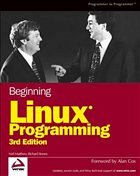Nicht lieferbar

Beginning Linux Programming
Versandkostenfrei!
Nicht lieferbar
Weitere Ausgaben:
"Beginning Linux Programming" - Jetzt erscheint der Marktführer und Bestseller unter den Linux-Programmierbüchern für Anfänger in der 3. komplett überarbeiteten, aktualisierten und erweiterten Auflage."Beginning Linux Programming" ist ein einzigartiger, verständlich geschriebener und gut strukturierter Leitfaden, der Anfänger mit der UNIX Programmierung auf der Linux Plattform vertraut macht. Der Band gibt eine fundierte und detaillierte Einführung in die Grundlagen der Linux Programmierung und geht auch auf fortgeschrittene Themen ein, wie z.B. Socket-Programmierung, Verwenden von MyS...
"Beginning Linux Programming" - Jetzt erscheint der Marktführer und Bestseller unter den Linux-Programmierbüchern für Anfänger in der 3. komplett überarbeiteten, aktualisierten und erweiterten Auflage.
"Beginning Linux Programming" ist ein einzigartiger, verständlich geschriebener und gut strukturierter Leitfaden, der Anfänger mit der UNIX Programmierung auf der Linux Plattform vertraut macht. Der Band gibt eine fundierte und detaillierte Einführung in die Grundlagen der Linux Programmierung und geht auch auf fortgeschrittene Themen ein, wie z.B. Socket-Programmierung, Verwenden von MySQL, Entwickeln von GNOME- und KDE-Anwendungen, POSIX Threads und Kernel Programmierung für den neuesten Linux Kernel. Mit neuen Kapiteln, u.a. zu folgenden Themenschwerpunkten: MySQL, GNOME, KDE, Linux Standards für tragbare Anwendungen, Kernel-Programmierung und GUI Entwicklungsumgebungen. Mit ausführlichem Beispielmaterial aus der Praxis. Ein typisches Wrox Press-Buch für Anfänger: Geschrieben von Programmierern für Programmierer. Es vermittelt alle notwendigen Grundkenntnisse, praktische Übungen und bewährte Übungstechniken.
----------------------------------------
Completely revised and updated, this bestseller continues to offer a unique, straightforward, and structured approach to learning UNIX programming on the Linux platform.
New chapters cover topics such as MySQL access and administration, programming GNOME using the GTK GNOME architecture, programming KDE using Qt, and Linux standards for portable applications.
Selling Points
- Offers in-depth coverage of Linux programming basics for the reader needing a thorough introduction
- Detailed and realistic examples help readers learn by doing, enabling them to move from programming basics to sophisticated custom applications
- Covers C programming fundamentals on the Linux platform, including material on basic system calls, file I/O, interprocess communication, and shell programming
"Beginning Linux Programming" ist ein einzigartiger, verständlich geschriebener und gut strukturierter Leitfaden, der Anfänger mit der UNIX Programmierung auf der Linux Plattform vertraut macht. Der Band gibt eine fundierte und detaillierte Einführung in die Grundlagen der Linux Programmierung und geht auch auf fortgeschrittene Themen ein, wie z.B. Socket-Programmierung, Verwenden von MySQL, Entwickeln von GNOME- und KDE-Anwendungen, POSIX Threads und Kernel Programmierung für den neuesten Linux Kernel. Mit neuen Kapiteln, u.a. zu folgenden Themenschwerpunkten: MySQL, GNOME, KDE, Linux Standards für tragbare Anwendungen, Kernel-Programmierung und GUI Entwicklungsumgebungen. Mit ausführlichem Beispielmaterial aus der Praxis. Ein typisches Wrox Press-Buch für Anfänger: Geschrieben von Programmierern für Programmierer. Es vermittelt alle notwendigen Grundkenntnisse, praktische Übungen und bewährte Übungstechniken.
----------------------------------------
Completely revised and updated, this bestseller continues to offer a unique, straightforward, and structured approach to learning UNIX programming on the Linux platform.
New chapters cover topics such as MySQL access and administration, programming GNOME using the GTK GNOME architecture, programming KDE using Qt, and Linux standards for portable applications.
Selling Points
- Offers in-depth coverage of Linux programming basics for the reader needing a thorough introduction
- Detailed and realistic examples help readers learn by doing, enabling them to move from programming basics to sophisticated custom applications
- Covers C programming fundamentals on the Linux platform, including material on basic system calls, file I/O, interprocess communication, and shell programming




